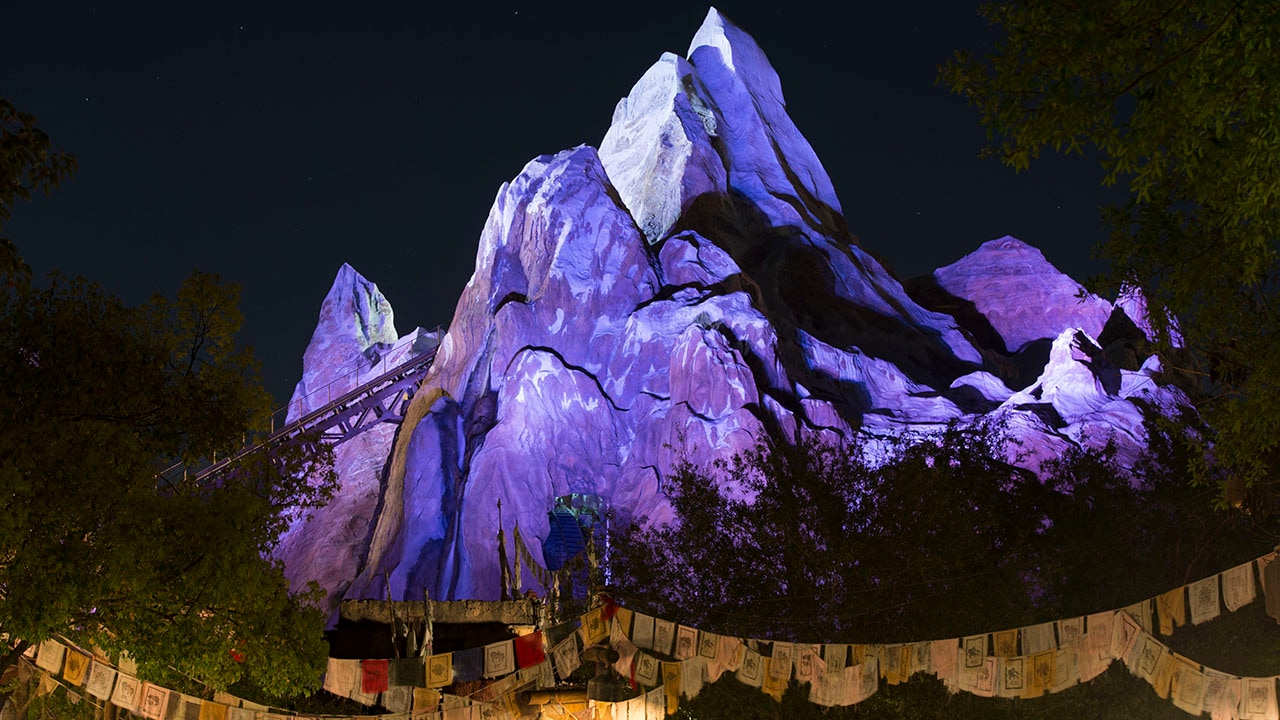Expedition Everest is one of the most exciting and unique thrill rides Walt Disney World offers. If anyone in your family likes roller coasters, they will surely be curious about this ride during your Animal Kingdom visit.
But while some kids love scary rides, they might still have boundaries on what they can handle. Every parent who has visited a theme park has heard the classic roller coaster litmus question: does this ride go upside down?
“Expedition Everest – Legend of the Forbidden Mountain” does not go upside down, but it does feature some high-speed turns, extreme drops, and a brief journey backward on the track.
Read on to learn more about what to expect on Expedition Everest and whether it’s a good fit for your tiny Disney adventurer.
What is Expedition Everest in Animal Kingdom?
Expedition Everest is a roller coaster located in the Asia section of Animal Kingdom. At 199 feet, this ride is the highest artificial mountain in all the Walt Disney properties.
Opened in 2006, Expedition Everest garnered media attention for its intricate construction and expensive cost—Disney spent about $100 million on this roller coaster. The ride features impressive engineering and design, including a multi-direction track switch system and a 25-foot-tall audio-animatronic Yeti.
Contrary to the common assumption, the mountain facade is not supposed to be a replica of Mount Everest. Instead, it is the “Forbidden Mountain” next to Mount Everest, where the scary Yeti monster resides.
The ride takes you on a thrilling journey on the mountain train, complete with the Yeti ripping up the track and a large drop at the end.

What To Expect on Expedition Everest
The legend of the Yeti is the focus of the Expedition Everest ride, and a snow monster resides on the forbidden mountain and chases away unwanted visitors. This popular roller coaster tends to have a long wait time, but the queue area is engaging and introduces you to the ride’s premise while you pass the time.
The queue starts in a Himalayan travel agency and proceeds into a temple and tea garden area. These spaces have plenty of fun details for ride-goers to explore while they wait in line.
As you get closer to the ride, the decor changes to show equipment from mountain climbing missions, leading you into a Yeti Museum that displays artifacts of the legendary monster.
Riders board the roller coaster at the village station, where they will begin their ascent up the mountain. The ride vehicle is a train that seats two people per row, and the seats feature individual lap bars to keep riders safe and secure.
As you ride up the mountain, you hear Yeti noises around you. At the top of the hill, the ride introduces a twist: the train will suddenly stop at a broken track and begin to go backward.
The Yeti eventually changes the track, and you move forwards again, completing the ride with a final significant drop and a glimpse at the massive animatronic monster. The ride duration is two minutes and 50 seconds.
Biggest Drop
Although the ride never goes upside down, there are some fairly significant drops and turns. After a minor drop at the beginning of the ride, most drops and turns occur as the train moves backward.
Once your train returns to going forwards, you should prepare for the ride’s big, culminating drop. Expedition Everest’s final plunge is 80 feet high and takes you at a speed of 50 miles per hour.
In the grand scheme of roller coasters, this isn’t that big of a drop, but it is one of the scariest attractions Disney World offers and can be intense for someone used to gentler rides.

Going Backwards
Expedition Everest’s notable feature is that it goes backward. Disney accomplishes this by using subtle track switches that create the illusion of seamless, out-of-control train movement.
The maximum backward speed for Expedition Everest is 30 miles per hour, so be prepared to move backward quickly while taking some sharp turns and dips.
Generally, backward motion isn’t as disorienting an experience for people as going upside down. The sharp, high-speed motion can cause nausea or distress for some people, especially as you spend a large portion of the ride in the dark.
Noise and Imagery
Aside from big drops and going backward, the only other factor that may deter young riders is the scary noise and imagery.
Throughout the ride, you see evidence of the Yeti’s destruction, including hurtling towards a broken track at a high height, only to stop abruptly and change direction. Expedition Everest also has an audio track that features loud, intimidating monster roars.
At the end of the ride, you will see a giant animatronic Yeti that roars and swipes at the train with his hand. The Yeti character is a fun element of the ride, but it may be intimidating for younger kids and those sensitive to loud noises and bright lights.
Frequently Asked Questions
Here are the answers to some of the most frequently asked questions about Expedition Everest and other scary Disney rides.
How long does Expedition Everest go backward?
Expedition Everest goes backward for only about thirty seconds. It may feel longer since you spend this time in the dark.
Do any Disney rides go upside down?
The only Disney World ride that goes upside down is the Rock ‘n’ Roller Coaster, located in the Hollywood Studios park.
Is Expedition Everest scarier than Splash Mountain?
Most people find Expedition Everest to be scarier than Splash Mountain. Splash Mountain—the Magic Kingdom water ride soon to be refurbished as Tiana’s Bayou Adventure—has a 49-foot final drop, and does not have the high speeds and sharp turns that Expedition Everest has.
Final Thoughts
Expedition Everest doesn’t go upside down, so if that’s someone’s only roller coaster boundary, they should be able to enjoy this ride. Aside from big drops and going backward, Expedition Everest should be a fun ride for anyone who enjoys moderate-intensity roller coasters.
More about our TFVG Author
A seasoned traveller, Dad, and avid sports tourist, James foundered The Family Vacation Guide to share his expert vacation experiences- especially when it comes to being a travelling family man.
Featured in Travel articles such as Travel + Leisure, TripSavvy and SFGate, you know you're reading some of the best vacation tips online.





